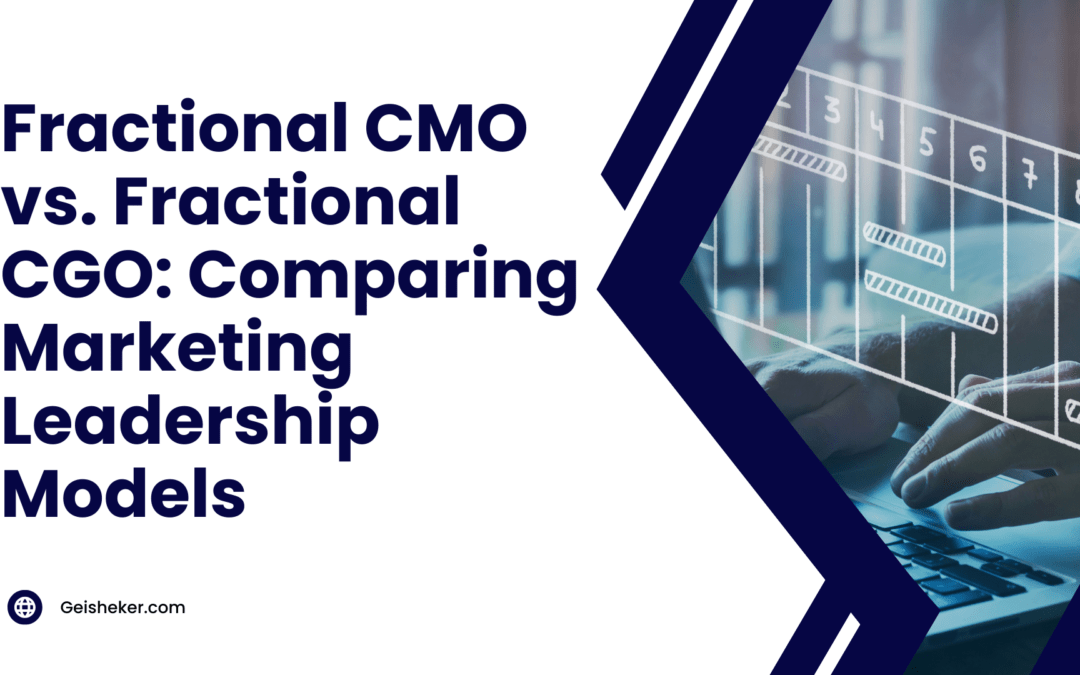As startups scale, founders often grapple with the question of whether to bring on an in-house marketing or growth leader, or to work with one in a fractional capacity. The two main options here are usually hiring a fractional Chief Marketing Officer (fCMO) or a fractional Chief Growth Officer (fCGO). There are some key differences between these roles and pros and cons to weigh when deciding which type of leader to bring onto your team.
Fractional CMO
A fractional CMO is a marketing expert who works on a part-time or project basis, guiding the marketing strategy and managing activities like branding, positioning, advertising, and communications. They understand how to connect with customers, craft effective messaging, and build awareness – critical early-stage growth capabilities.
Fractional CGO
A fractional CGO focuses squarely on growth strategies and conversion rate optimization. They specialize in areas like viral loops, referral programs, and sales funnels – rigorous growth levers to help startups scale quickly. Less involved in general marketing activities, the fractional CGO instead prioritizes analytics and measurable acquisition tactics.
The Divide Between the CMO and CGO
The divide between the CMO and CGO comes down to a focus on brand-building versus direct-response growth. Early on, startups need a bit of both, but may choose to lean more heavily on one or the other depending on business model, budget, and existing capabilities in-house.
When it comes to pros and cons:
Hiring a fractional CMO allows startups to…
- Tap into marketing expertise without a full salary commitment
- Craft cohesive messaging and positioning
- Build brand awareness and affinity
Potential downsides include…
- Less focus on performance marketing and conversion optimization
- Brand-building activities can be harder to measure
Engaging a fractional CGO enables startups to…
- Implement data-driven growth tactics
- Quickly test and optimize conversion funnels
- Cost-effectively scale new user acquisition
But this route may lack…
- High-level brand and communications perspective
- Qualitative insights into customer perspectives
Considerations
There are a few key considerations when deciding between hiring a fractional marketing or growth leader:
- Current business stage – Early-stage startups may benefit more from CMO support to articulate unique value proposition and identity. More mature startups likely need CGO support to keep scaling efficiently.
- Existing capabilities – If the founding team lacks brand, creative, and communications experience, a CMO may fill important gaps. Whereas startups with solid marketing foundations may gain more from a data-driven CGO.
- Budget and metrics – CMOs may require more patience as brand lift can take time. CGOs offer rapid optimization cycles and direct performance data. Startups need to decide which capabilities and metrics align best with investor expectations.
In some cases, engaging both a fractional CMO and CGO can provide complementary benefits – brand-building plus performance marketing. Though more affordable than full-time executives, the budget may still limit this route requiring tradeoffs.
Ultimately there is no “right choice” between hiring a CMO or CGO – it depends on business context, available resources, and overall objectives during a startup’s unique stage of growth. Founders must clearly define priorities and growth milestones, then determine which fractional exec is the best fit to achieve them. With clear goals and working closely across the leadership team, part-time marketing and growth leaders can provide tremendous leverage at prices startups can afford.
Fractional CMO vs CGO Cheat Sheet
The Difference Between a Fractional CMO and CGO
Defining the Roles
- A fractional CMO oversees marketing strategy and branding activities
- A fractional CGO focuses specifically on growth tactics and conversion
CMO Responsibilities
- Crafting positioning and messaging
- Building brand awareness and affinity
- Qualitative customer insights
CGO Responsibilities
- Implementing viral loops and sales funnels
- Data-driven conversion optimization
- Scaling new user acquisition
The Pros and Cons of Each
Fractional CMO Pros
- Marketing expertise without full salary
- Cohesive messaging and positioning
- Brand awareness benefits
Fractional CMO Cons
- Less focus on optimization
- Harder to measure brand-building
Fractional CGO Pros
- Data-driven growth tactics
- Conversion funnel optimization
- Cost-effective user acquisition scaling
Fractional CGO Cons
- Lacks high-level brand perspective
- Misses qualitative customer insights
Key Considerations for Your Startup
- Current business stage
- Existing capabilities
- Budget and metrics
Sometimes hiring both CMO and CGO can provide ideal blend of brand-building and performance marketing. But budgets may require tradeoffs between the two.
The Importance of Defining Priorities and Milestones
Ultimately, founders must:
- Set clear objectives
- Prioritize growth milestones
- Determine which fractional executive is the best fit
With defined goals and close leadership team collaboration, part-time marketing and growth experts can provide tremendous leverage at affordable costs.
Get a B2B SaaS Fractional CMO & CGO in One Person
If your company needs a B2B SaaS Fractional CMO, and a CGO, consider working with Peter Geisheker, CEO of The Geisheker Group. Peter has been providing Fractional CMO services for over 20 years and has expertise in growth tactics and conversion optimization.


